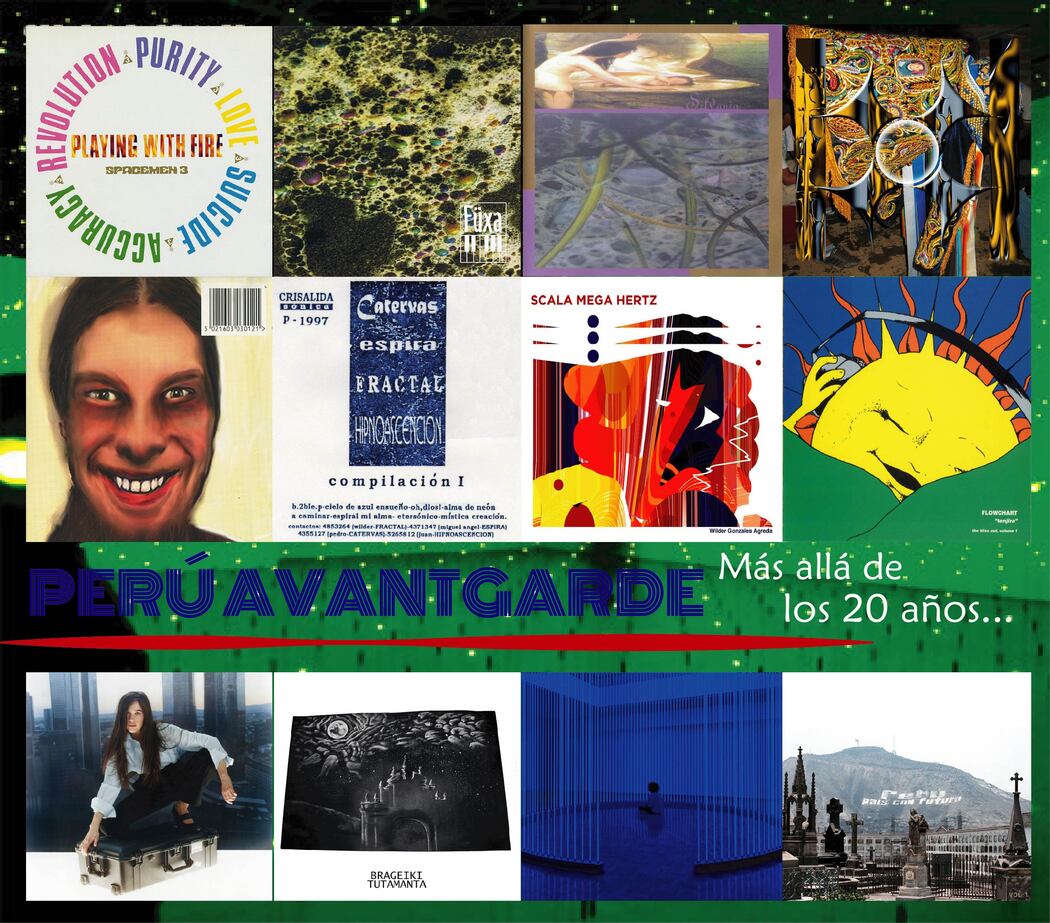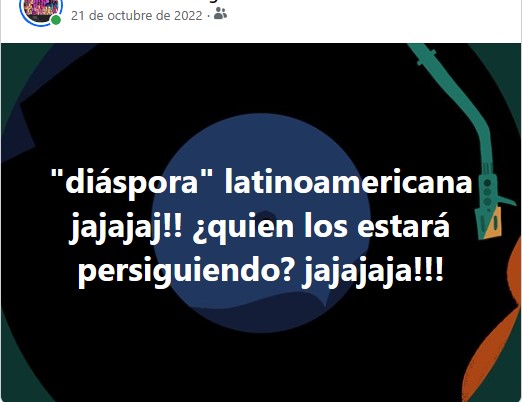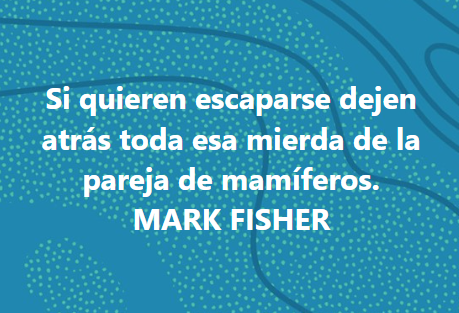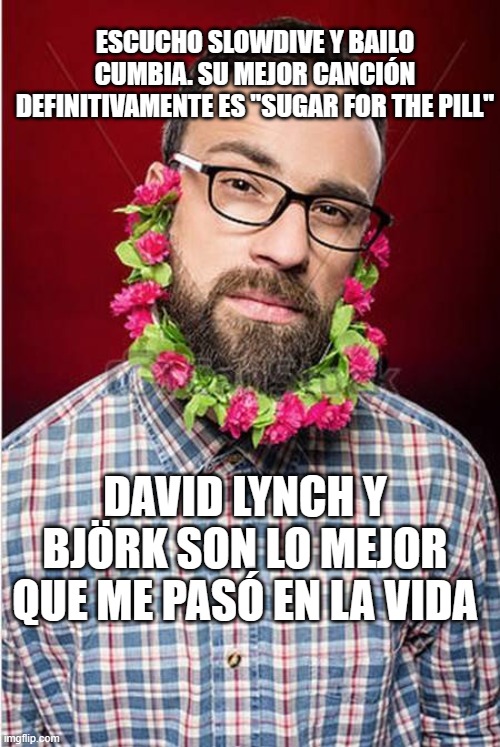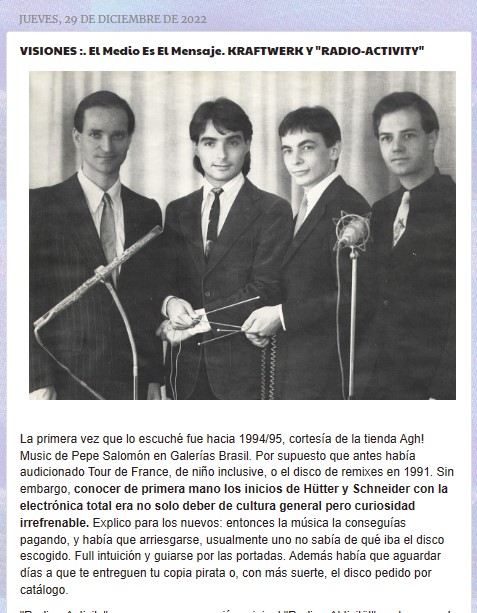Marcellus Lewis (46) es un portento usamericano dedicado a construir canciones de electrónica avantgarde para embellecer la mente. Adicto al post rock y shoegaze de siempre, en su sonido podemos detectar influencias del lustre de Flowchart, Lali Puna o Transient Waves. Así de perfecto y hermoso. Le conocí circa 2005, en los años del myspace, cuando le propuse formar parte del compilado "Caminando Sobre Nubes" (Superspace Records, 2006) que publicáramos con la revista Freak Out! Su música me parecía tan cara que puse a Colortone Library abriendo el disco con "happenchance", y vaya que la competencia fue rigurosa. El CD incluye tracks de Brian Jonestown Massacre -contacté con el grupo a través del manager-, lovesliescrushing, Tica, Duelectrum, et al.
Cancelada (o quizás no, todo es posible) la faceta Colortone Library -cuyo único álbum conservo cual joya-, Marcellus se dedicaría a regalar florituras a través de su proyecto solista Microholiday. Recomiendo mucho insuflar el aura con "Slanted Sun Through Greenhouse Moments" (Yellow Fantastic Recordings, 2010) -algo así como "Sol rasante a través de momentos invernadero"- al menos una vez en esta vida. De sus proyectos, inicios en la música y más nos habla este maestro etéreo ad portas de lanzar una nave más como dejando constancia de su presencia en la Tierra.
¿Con qué música/sonidos creciste y cómo descubriste el mundo del post rock, la música etérea y la electrónica?
Creo que mi verdadera experiencia formativa en la música comenzó con algunas de las cosas deprimidas, en su mayoría británicas, que mi hermana mayor escuchaba en los años 80: Depeche Mode, The Cure, New Order, etc. Me gustaba mucho The Cure en la escuela secundaria y preparatoria y ese tipo de sonido fue fundamental para mí; posteriormente me atrajo otra música gótica/darkwave como Siouxsie & the Banshees, Cranes, algunos de los actos del sello Projekt (Black Tape for a Blue Girl, lovesliescrushing, Lycia, Love Spirals Downwards), etc. A mediados y finales de los 90 descubrí el shoegaze, el rock espacial y similares gracias a un programa llamado Postscript en WRAS, la estación de radio de la Universidad Estatal de Georgia (y otro programa llamado Psych Out en WREK, la estación de Georgia Tech). Un programa de radio de California llamado Hearts of Space me puso en contacto con música más puramente ambiental y "espacial". Durante ese mismo tiempo me estaba enamorando de Stereolab, Cocteau Twins, Slowdive, My Bloody Valentine, Broadcast, Aphex Twin y Dead Can Dance. Algunos favoritos más oscuros incluyeron Füxa, Bowery Electric, Mahogany, Auburn Lull, Flying Saucer Attack, Amp, Windy and Carl y Azusa Plane. Hay muchos más que podría enumerar... Boards of Canada, Pia Fraus, Lali Puna, Arovane, Neu!, Kraftwerk, The American Analog Set, minimal wave de principios de los 80 (por ejemplo, Deux)... Un recuerdo particular que tengo es escuchar Slowdive por primera vez en la radio en un auto, y pensé que algo andaba mal con la radio. Nunca había escuchado algo tan difuminado, y me afectó profundamente.
Has pasado por proyectos underground con buena música, como Colortone Library y Microholiday, cuéntanos cómo fueron estas experiencias.
Colortone Library fue/es un esfuerzo conjunto entre Michael Wellman y yo. Siempre hemos tenido gustos musicales similares y hemos sido amigos cercanos desde la escuela secundaria. Habíamos estado juntos en una banda de grunge, pero teníamos gustos comunes en lo etéreo, ambiental, IDM, etc., así que decidimos tratar de sacar algo juntos alrededor de 2006 (a pesar de que ya me había mudado a Denver en ese momento). Enviamos material de un lado a otro y de alguna manera logramos completar un álbum entero. Me doy cuenta de que han pasado 15 años, pero no descarto otro lanzamiento, todo es posible. Microholiday fue solo un proyecto paralelo en solitario que creé mientras vivía en Praga, donde exploré la calidad y el tono de la producción más que cualquier tipo de tema o mensaje, pero supongo que la música se consideraría de naturaleza electrónica/synth pop experimental. Luego está Nitewife, otro proyecto del que formo parte con Jason Iselin, una especie de sonido de onda oscura/onda mínima que se encuentra con el kraut.
¿Cuál es tu equipo actual? Sintetizadores, software, etc.
A pesar de tener acceso a una gran cantidad de parches de software, tiendo a preferir usar dispositivos físicos para la mayoría de los sonidos. Mis dos fuentes de sonido principales son un sintetizador de modelado analógico (Korg MS2000), así como un sintetizador analógico verdadero (Dave Smith MoPho), y también uso bastante un Yamaha VSS-30 para samplear ruido, ritmos y sonidos de sintetizador lo-fi, ya que crea algunos tonos hermosos. Para los ritmos y algunos otros sonidos electrónicos suelo usar Reason. Ocasionalmente también pruebo guitarra acústica y bajo eléctrico.
En este momento estoy viviendo en el país de Georgia, pero planeo mudarme pronto a los EE. UU. o Europa. Mi trayectoria profesional está en la educación, así como en la escritura/edición en varios contextos. He estado en la fotografía de vez en cuando desde los años 90, y estoy muy interesado en la nutrición/alimentos como medicina.
¿Qué otros proyectos o grupos recomendarías a los lectores del blog?
Seguramente dejaré algunos, pero aquí hay algunos que me vienen a la mente. Boards of Canada es bastante conocido, pero sigo inspirándome en la calidad tonal de su música. En general, me encantan sus composiciones, pero en mi opinión, su capacidad para crear una textura única que combina a la perfección elementos de baja fidelidad y alta fidelidad es inigualable. Algunos otros que me han atraído últimamente: Hologram Teen; Daniel Avery (específicamente el LP Illusion of Time - una exploración experimental, atmosférica y meditativa). Cavern of Anti-Matter; Mint Julep; Black Marble; Emily A. Sprague; Bitchin Bajas; Sinoia Caves (más allá de la banda sonora de Black Rainbow); Sophie & Peter Johnston (la canción de los 80 “Sold on You” - Me encanta esta canción y su calidad de producción); You’ll Never Get to Heaven; Conciertos para clavecín de Bach.
Acabas de lanzar un sencillo electro etéreo en bandcamp y nos dices que estás a punto de lanzar un nuevo álbum. Por favor, detalla este asunto. ¿Cuántos temas, títulos, colaboradores, sello, etc.?
Bueno, el álbum tiene casi una hora de duración con ocho pistas. Sin duda, es la música ambiental más downtempo que he creado hasta ahora. Creo que algo de eso funcionaría bastante bien para bandas sonoras o material underscore para películas/documentales, por lo que existe la posibilidad de que renuncie a un lanzamiento tradicional si encuentro una oportunidad para ello en películas/videos. El álbum es el cuarto lanzamiento bajo mi propio nombre. Como con la mayoría de mis proyectos, está en mi sello casero Yellow Fantastic Recordings. Ha sido un esfuerzo completamente en solitario, producido principalmente en el país de Georgia, pero algunas de las pistas se iniciaron hace casi 20 años.
Siendo ciudadano estadounidense, estamos más que seguros de que ha disfrutado de conciertos memorables. ¿Cuáles dirías que son los recitales que golpearon tu alma o tu mente y que atesoras hasta el día de hoy?
En efecto. He tenido la suerte de ver algunos de mis favoritos...
Atlanta, Georgia a principios de los 90: Man or Astroman?; Floraline; Swans; The Cure; The Gloria Record; Underwater
Atlanta, Georgia a finales de los 90: The Mercury Program, Tortoise, Bowery Electric, Dead Can Dance, Built to Spill, Tristeza, Windy and Carl, Stereolab, Sonic Youth, Japancakes; God Speed You Black Emperor; Low.
Chapel Hill, Carolina del Norte a finales de los 90: Stereolab
Denver, Colorado en la década de 2000: The American Analog Set; Tamarin; The Flaming Lips.
Praga, CZ en 2008: Telefon Tel Aviv; Casiotone for the Painfully Alone.
Los mejores de los mejores fueron Bowery Electric, Built to Spill, Dead Can Dance, Windy and Carl, Stereolab y Tristeza. Todos eran mágicos y surrealistas por varias razones.
Ah, y también vi Massive Attack en vivo, pero, por desgracia, solo fue en un sueño que tuve.
Marcellus Lewis (46) is an American wonder dedicated to building avantgarde electronic songs to beautify the mind. Addicted to the usual post rock and shoegaze, in his sound we can detect influences like Flowchart, Lali Puna or Transient Waves. So perfect and beautiful. I met him around 2005, in the myspace years, when I asked him to be part of the compilation "Caminando Sobre Nubes" (Superspace Records, 2006) that we released with Freak Out! magazine. His music seemed so valuable to me that I put Colortone Library opening the album with "happenchance", and boy was the competition rigorous. The CD includes tracks by Brian Jonestown Massacre -I contacted the group through the manager-, lovesliescrushing, Tica, Duelectrum, et al.
Canceled the Colortone Library facet (or maybe not, everything is possible) -whose only album I keep as a jewel-, Marcellus would dedicate himself to giving flourishes through his solo project Microholiday. I highly recommend infusing the aura with "Slanted Sun Through Greenhouse Moments" (Yellow Fantastic Records, 2010) at least once in this lifetime. About his projects, beginnings in music and more speaks to us this ethereal maestro on the verge of launching one more ship as leaving evidence of his presence on Earth.
What music/sounds did you grow up with and how did you discover the world of post rock, ethereal music and electronica?
I think my truly formative experience in music started with some of the moody, mostly British stuff my older sister was listening to in the 80s - Depeche Mode, The Cure, New Order, etc. I was really into The Cure in middle school and high school, and that sort of sound was foundational for me; I was subsequently drawn to other goth/darkwave music like Siouxsie & the Banshees, Cranes, some of the acts on the Projekt label (Black Tape for a Blue Girl, loveliescrushing, Lycia, Love Spirals Downwards), and so on. In the mid- to late-90s I discovered shoegaze, space rock, and the like thanks to a show called Postscript on WRAS, Georgia State University's radio station (and another show called Psych Out on WREK, Georgia Tech’s station). A radio show out of California called Hearts of Space turned me on to some more purely ambient and ‘space’ music. During that same time I was falling in love with Stereolab, Cocteau Twins, Slowdive, My Bloody Valentine, Broadcast, Aphex Twin, and Dead Can Dance. Some more obscure favorites included Füxa, Bowery Electric, Mahogany, Auburn Lull, Flying Saucer Attack, Amp, Windy and Carl, and Azusa Plane. There are so many more I could list… Boards of Canada, Pia Fraus, Lali Puna, Arovane, Neu, Kraftwerk, The American Analog Set, early 80s minimal wave (e.g. Deux)… A particular memory I have is hearing Slowdive for the first time on the radio in a car, and I thought something was wrong with the radio. I’d never heard anything so washed out, and it deeply affected me.
You have gone through underground projects with great music, like Colortone Library and Microholiday, please tell us about what these experiences were like.
Colortone Library was/is a joint effort between Michael Wellman and myself. We’ve always had similar tastes in music and have been close friends since high school. We’d been in a grunge band together but had mutual tastes in ethereal, ambient, IDM, etc., so we decided to try to put something out together around 2006 (despite my already having moved to Denver by that time). We sent material back and forth and somehow managed to complete a full album. I’m realizing it’s been 15 years, but I won’t rule out another release—anything’s possible. Microholiday was just a solo side project I created while I was living in Prague where I explored production quality and tone more than any sort of theme or message, but I suppose the music would be considered experimental electronic/synth pop in nature. Then there’s Nitewife - another project I’m part of with Jason Iselin - A sort of darkwave/minimal wave-meets-kraut sort of sound.
What is your current equipment? Synths, software, etc.
Despite having access to a plethora of software patches, I tend to prefer using physical devices for most sounds. My main two sound sources are from an analog modeling synth (Korg MS2000) as well as a true analog synth (Dave Smith MoPho), and I also use a Yamaha VSS-30 quite a bit for sampling for noise, beats, and lo-fi synth sounds as it creates some beautiful tones. For beats and some other electronic sounds I usually use Reason. I also occasionally sample acoustic guitar and electric bass.
Besides creating music, what do you do?
Right now I’m living in the country of Georgia but plan to relocate soon either back to the US or Europe. My professional path is in education, as well as writing/editing in various contexts. I’ve been into photography off and on since the 90s, and I’m very interested in nutrition/food as medicine.
What other projects or groups would you recommend to blog readers?
Surely I’ll leave out quite a few, but here are some that come to mind. Boards of Canada is fairly well-known, but I continue to be inspired by the tonal quality of their music. I generally love their compositions, but their ability to create a unique texture that beautifully combines both lo-fi and hi-fi elements is unmatched in my opinion. A few others that I’ve been drawn to lately: Hologram Teen; Daniel Avery (specifically the Illusion of Time LP - an experimental, atmospheric, meditative exploration). Cavern of Anti-Matter; Mint Julep; Black Marble; Emily A. Sprague; Bitchin Bajas; Sinoia Caves (Beyond the Black Rainbow soundtrack); Sophie & Peter Johnston (the 80s track “Sold on You” - I love this song and its production quality); You’ll Never Get to Heaven; Bach’s Harpsichord Concertos.
You just released an electro ethereal single on bandcamp and you tell us you're about to release a new album. Please elaborate on this matter. How many themes, titles, collaborators, label, etc?
Well, the album is nearly an hour in length with eight tracks. It’s certainly the most downtempo, ambient music I’ve created so far. I think some of it would work quite well for soundtrack or underscore material for film/documentaries, so there’s a chance I will forgo a traditional release if I find an opportunity for it in film/video. The album is the fourth release-to-be under my own name. As with most of my projects, it’s on my homemade label Yellow Fantastic Recordings. It’s been entirely a solo effort, mostly produced in the country of Georgia, but a few of the tracks were started nearly 20 years ago.
Being an American citizen we are more than sure that you have enjoyed memorable concerts. What would you say are the recitals that struck down your soul or mind and that you treasure to this day?
Indeed. I’ve been fortunate to see some of my favorites…
Atlanta, Georgia in the early 90s: Man or Astroman?; Floraline; Swans; The Cure; The Gloria Record; Underwater
Atlanta, Georgia in the late 90s: The Mercury Program, Tortoise, Bowery Electric, Dead Can Dance, Built to Spill, Tristeza, Windy and Carl, Stereolab, Sonic Youth, Japancakes; God Speed You Black Emperor; Low
Chapel Hill, North Carolina in the late 90s: Stereolab
Denver, Colorado in the 2000s: The American Analog Set; Tamaryn; The Flaming Lips
Prague, CZ in 2008: Telefon Tel Aviv; Casiotone for the Painfully Alone
The best of the best were Bowery Electric, Built to Spill, Dead Can Dance, Windy and Carl, Stereolab, and Tristeza. They were all magical and surreal for various reasons.
Oh, and I also saw Massive Attack live, but alas, it was only in a dream I had.
